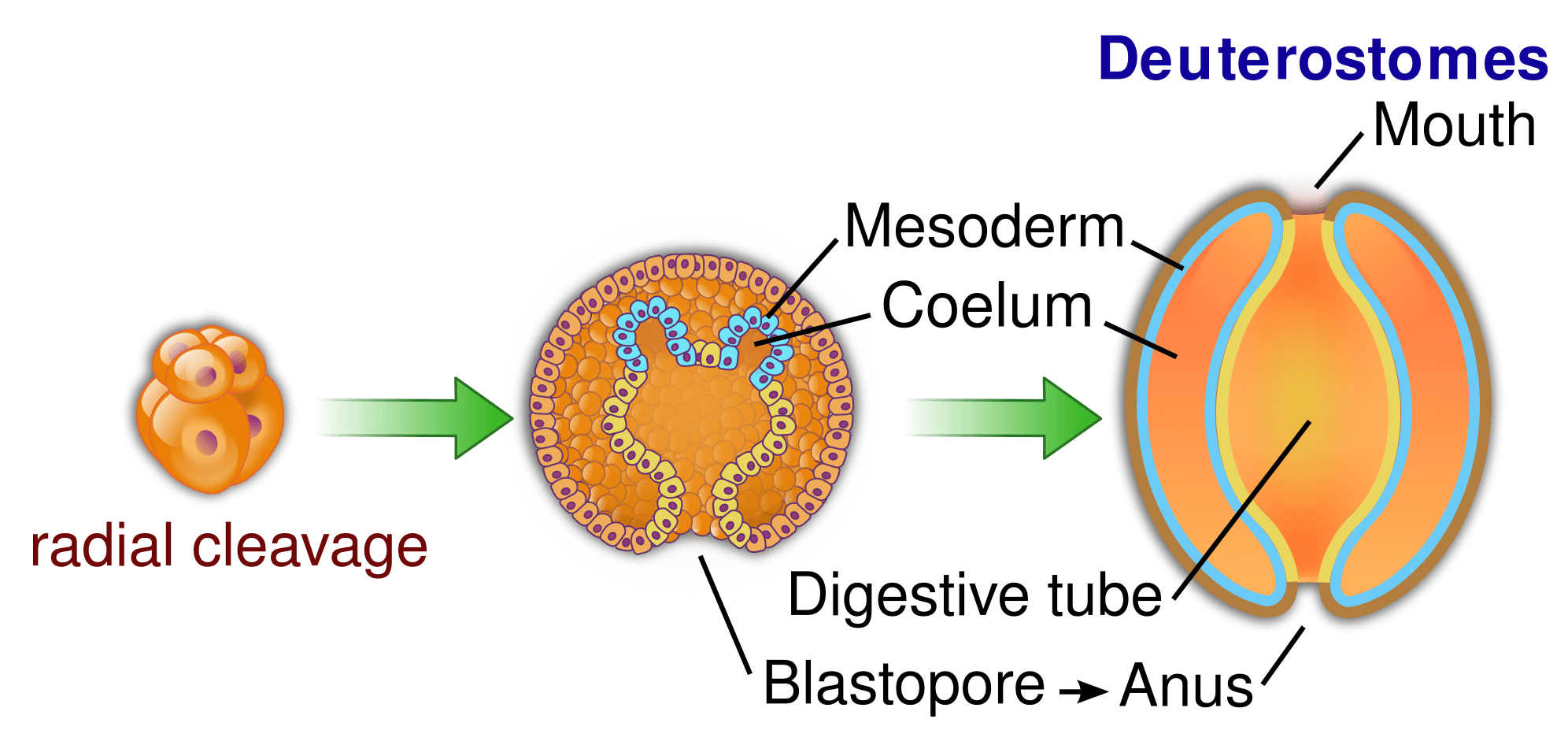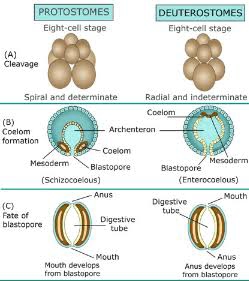The Bilateral (and Coelomate) phyla can be divided into two groups, variously called the Schizocoela and Enterocoela, or the Protostomia and Deuterostomia. These are distinguished by embryonic cleavage patterns, the fate of the blastopore and coelom formation. The Deuterostomes are a relatively small (in terms of species and abundance) group that includes vertebrates, echinoderms, and a few assorted minor phyla. We probably consider them (and specifically the vertebrates) important mainly for anthropocentric reasons (we are deuterostomes). The Protostomes in contrast include the great majority of animal species, such as arthropods, molluscs, annelids, and many less well-known taxa.
What Are Protostomes?
Protostomes are any of a major group of animals defined by its embryonic development, in which the first opening in the embryo becomes the mouth. Typically, the protostome condition is defined by a spiral and determinant cleavage in the early stages of embryo development, schizocoelous coelom formation (as the archenteron (embryonic gut) forms the coelom begins as splits within the solid mesodermal mass, and the formation of the blastopore (the original opening) into the mouth.
In other words, during protostome development the first opening to appear in a blastopore becomes the mouth of the organism. This pore deepens, forming the gut and eventually the anus. Protostomes exhibit spiral clevage in their cells, since each layer is offest slightly. Additionally the cells roles (i.e this cell will be a neuron) are determined very early on in development. The role is chosen, and stays as such in the organism’s adult form. The coelom of the organism develops through a process called schizocoely, in which masses from the mesoderm migrate and form the coelom.

Examples Of Protostomes
Protostomes includes organisms such as:
- Leeches
- Insects (beetles, ants, flies, crickets, butterflies, flees, cicada, bees)
- Spiders
- Crustaceans (crabs, lobsters, crayfish, woodlice, bernacles)
- Velvet worms
- Centipedes and millipedes
- Earthworms
- Squid
- Octopus
- Snail and slugs
- Bivalve mollusks (clams, oysters, mussels, scallops)
- Other less complex organisms.
Facts About Of Protostomes
- The blastopore in a protostome develops into a mouth.
- Protostomes are referred to as schizocoelomatesbecause the coelom is developed by splitting of the solid mass of the embryonic mesoderm.
- In protostomes, the gut is tunneled into embryo and forms anus.
- There is no archenteron development in protostomes. Archenteron is a rudimentary alimentary cavity formed during the early stages of embryo development. It usually develops into mosederm and endoderm of a living organism.
- Protostomes can be priapulids.
- The nervous system of protostomes is solid, ventral nerve cord. It is also important to note that many deuterostomes also have pharyngeal gill slits.
- Protostomes are less evolved and complex in their body compositions than Deuterostomes.
- Protostomes are multi-ciliated cells.
- All the remaining bilaterian phyla are grouped into protostomes or divided into two groups: protostomes and lophophorate.
- Protostomes contains less phyla and species than Deuterostomes.
- In protostomes, the anus arises secondarily.
- Protostomes exhibit determinate cleavage. Determinate cleavage is whereby the blastomere produced in the early stages of embryo development do not have capacity to develop into independent embryos.
- Protostomes undergo spiral cleavage. In spiral cleavage, the blastomeres of the animal pole are rotated with respect to those of the vegetal poles.
- Protostomes include flat worms, annelids, arthropods, mollusks and other less complex organisms.
What Are Deuterostomes?
The deuterostome condition is often associated with an initial embyonic cleavage pattern which is “radial” and in which cleavage planes are either parallel or perpendicular to the vertical axis of the embryo. Deuterostomes also commonly exhibit an indeterminate cleavage in the early stages of embryo development. That is, each early embryonic cell retains the capacity to develop into a complete embryo if isolated from other cells. (This enables the production of twins in vertebrates.). Deuterostomes also possess enterocoelous coelom development, in which the mesoderm arises as lateral outpocketings of the archenteron (embryonic gut) with hollows that become the coelomic cavities, and the development of the embryonic blastopore (the original opening) into the anus (rather than into the mouth as in most protostomes).

Examples Of Deuterostomes
Examples Of Deuterostomes Include:
- Echinodermata e.g starfish, sea urchin, crinoids, sea cucumber, blastoid, cystoidea, Eocrinoidea etc.
- Chordates include marine and terrestrial animals (mammals, reptiles, amphibians, frog, turtle, lizard, bat, tetrapods, Sloth, and jawless fish).
- Cephalochordata e.g lancelets
- Urochordata which includes tunicates (sea squirts), Ascidians, Larvacea, Thaliacea etc.
- Vertebrata
- Hemichordata e.g planctosphaeroidea, graptolithina, pterobranchia, acorn worm
- Hemichordates and other higher and complex organisms
- Deuterostomes includes higher animals like human beings, monkeys, birds etc.
Facts About Of Deuterostomes
- The blastopore in deuterostomes develops into an anal opening.
- Deuterostomes are referred to as enterocoelousbecause the longitudinal pouches of the archenteron forms the coelom.
- In deuterostomes , the mouth is formed by gut being tunneled into embryo.
- Deuterostomes have archenteron development in the early stages of embryo formation.
- Deuterostomes are always enterocoelous.
- The nervous system of deuterostomes is composed of hollow nerve cord.
- Deuterostomes are more evolved and complex in their body compositions than protostomes.
- Deuterostomes are all mono-cliated.
- Deuterostomes mainly includes echinoderms, hemichordes and chordates
- Deuterostomes contains less phyla and species than protostomes.
- In deuterostomes, the mouth arises secondarily.
- Deuterostomes exhibit indeterminate cleavage. Indeterminate cleavage is whereby all early blastomeres have the capacity to develop into a complete embryo.
- Deuterostomes undergo radial cleavage. In radial cleavage, the blastomeres of upper tiers are positions directly above those of lower tiers. This eventually results in radial symmetry across animal pole and vegetal pole.
- Deuterostomes include chordates, echinoderms, pogonophora, hemichordates and other higher and complex organisms. Deuterostomes includes higher animals like human beings, monkeys, birds etc.

Difference Between Protostomes And Deuterostomes In Tabular Form
| ELEMENTS OF COMPARISON | DEUTEROSTOMES | PROTOSTOMES |
| Blastopore | Blastopore in deuterostomes develops into an anal opening. | The blastopore in a protostome develops into a mouth. |
| Coelom | They are referred to as enterocoelous because the longitudinal pouches of the archenteron forms the coelom. | They are referred to as schizocoelomates because the coelom is developed by splitting of the solid mass of the embryonic mesoderm. |
| Mouth & Anus | The mouth is formed by gut being tunneled into embryo. | The gut is tunneled into embryo and forms anus. |
| Archenteron | Have archenteron development in the early stages of embryo formation. | There is no archenteron development. |
| Nature | They are always enteroceolus. | They can be priapulids. |
| Nervous System | The nervous system is composed of hollow nerve cord and pharyngeal gill slits. | The nervous system is solid, ventral nerve cord. |
| Evolution | They are more evolved and complex in their body compositions. | They are less evolved and simple in their body compositions. |
| Cell Ciliation | They are all mono-ciliated. | They are multi-ciliated cells. |
| Division | They mainly include echinoderms, hemichordes and chordates | All the remaining bilaterian phyla are grouped into protostomes or are divided into two groups: protostomes and lophophorate. |
| Number Of Phyla | Deuterostomes contains less phyla and species than protostomes. | |
| Anus & Mouth Development | The mouth arises secondarily. | The anus arises secondarily. |
| Cleavage | Exhibit indeterminate cleavage. | Exhibit determinate cleavage. |
| Cleavage Shape | Undergoes radial cleavage. | Undergoes spiral cleavage. |
| Examples | Chordates, Echinoderms Pogonophora, Hemichordates and other higher and complex organisms. | Flat worms, Annelids, Arthropods, Mollusks and other less complex organisms. |